
Andrew Johnson was the 17th president of the United States, serving from 1865 to 1869. He assumed the presidency following the assassination of Abraham Lincoln, as he was vice president at that time. Johnson was a Democrat who ran with Abraham Lincoln on the National Union Party ticket, coming to office as the Civil War concluded. He favored quick restoration of the seceded states to the Union without protection for the newly freed people who were formerly enslaved as well as pardoning ex-Confederates. This led to conflict with the Republican-dominated Congress, culminating in his impeachment by the House of Representatives in 1868. He was acquitted in the Senate by one vote.

Hannibal Hamlin was an American attorney and politician who served as the 15th vice president of the United States from 1861 to 1865, during President Abraham Lincoln's first term. He was the first Republican vice president.
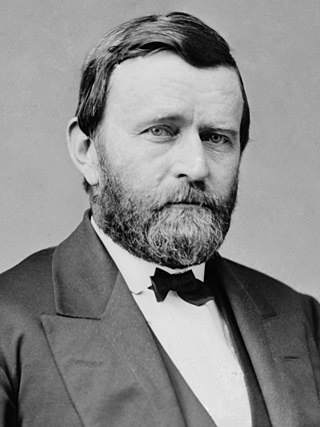
The 1868 United States presidential election was the 21st quadrennial presidential election, held on Tuesday, November 3, 1868. In the first election of the Reconstruction Era, Republican nominee Ulysses S. Grant defeated Horatio Seymour of the Democratic Party. It was the first presidential election to take place after the conclusion of the American Civil War and the abolition of slavery. It was the first election in which African Americans could vote in the reconstructed Southern states, in accordance with the First Reconstruction Act.

The Reconstruction era was a period in United States history and Southern United States history that followed the American Civil War and was dominated by the legal, social, and political challenges of the abolition of slavery and the reintegration of the eleven former Confederate States of America into the United States. During this period, three amendments were added to the United States Constitution to grant citizenship and equal civil rights to the newly freed slaves. To subvert this legal achievement, the former Confederate states imposed poll taxes and literacy tests, and carried out acts of terrorism to intimidate and control people of color and to discourage or prevent them from voting.
The Radical Republicans were a political faction within the Republican Party originating from the party's founding in 1854—some six years before the Civil War—until the Compromise of 1877, which effectively ended Reconstruction. They called themselves "Radicals" because of their goal of immediate, complete, and permanent eradication of slavery in the United States. The Radical faction also included, though, very strong currents of Nativism, anti-Catholicism, and in favor of the Prohibition of alcoholic beverages. These policy goals and the rhetoric in their favor often made it extremely difficult for the Republican Party as a whole to avoid alienating large numbers of American voters from Irish Catholic, German-, and other White ethnic backgrounds. In fact, even German-American Freethinkers and Forty-Eighters who, like Hermann Raster, otherwise sympathized with the Radical Republicans' aims, fought them tooth and nail over prohibition.
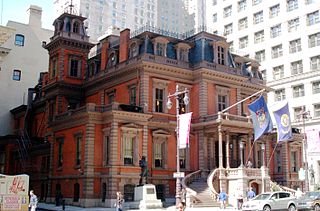
The Union Leagues were quasi-secretive men's clubs established separately, starting in 1862, and continuing throughout the Civil War (1861–1865). The oldest Union League of America council member, an organization originally called "The League of Union Men", was formed in June 1862 in Pekin, Illinois. Four months later, on November 22, 1862, the Union League of Philadelphia, the first of the elite eastern Leagues and the second oldest ULA council member, was established.
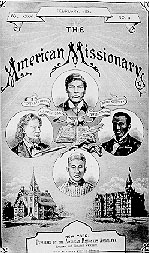
The American Missionary Association (AMA) was a Protestant-based abolitionist group founded on September 3, 1846 in Albany, New York. The main purpose of the organization was abolition of slavery, education of African Americans, promotion of racial equality, and spreading Christian values. Its members and leaders were of both races; The Association was chiefly sponsored by the Congregationalist churches in New England. The main goals were to abolish slavery, provide education to African Americans, and promote racial equality for free Blacks. The AMA played a significant role in several key historical events and movements, including the Civil War, Reconstruction, and the Civil Rights Movement.
Michael Les Benedict is an American historian, who taught at Ohio State University from 1970 until his retirement in 2005. He received his B.A. and M.A. degrees from the University of Illinois and his PhD from Rice University. His expertise is principally in constitutional and legal history, civil rights and civil liberties, and the American Civil War and Reconstruction. Benedict brings a political science approach to his analysis of historical events. Benedict has contributed several works to the field of Civil War and Reconstruction studies including The Impeachment and Trial of Andrew Johnson (1973), A Compromise of Principle: Congressional Republicans and Reconstruction, 1863-1869 (1975), Fruits of Victory: Alternatives in Restoring the Union, 1865-1877 (1986), and, more recently, Preserving the Constitution: Essays on Politics and the Constitution in the Reconstruction Era (2006).

Tennessee is one of the 50 states of the United States. What is now Tennessee was initially part of North Carolina, and later part of the Southwest Territory. It was admitted to the Union on June 1, 1796, as the 16th state. Tennessee earned the nickname "The Volunteer State" during the War of 1812, when many Tennesseans helped with the war effort, especially during the Americans victory at the Battle of New Orleans in 1815. The nickname became even more applicable during the Mexican–American War in 1846, after the Secretary of War asked the state for 2,800 soldiers, and Tennessee sent over 30,000 volunteers.

The impeachment of Andrew Johnson was initiated on February 24, 1868, when the United States House of Representatives passed a resolution to impeach Andrew Johnson, the 17th president of the United States, for "high crimes and misdemeanors". The alleged high crimes and misdemeanors were afterwards specified in eleven articles of impeachment adopted by the House on March 2 and 3, 1868. The primary charge against Johnson was that he had violated the Tenure of Office Act. Specifically, that he had acted to remove from office Edwin Stanton and to replace him with Brevet Major General Lorenzo Thomas as secretary of war ad interim. The Tenure of Office Act had been passed by Congress in March 1867 over Johnson's veto with the primary intent of protecting Stanton from being fired without the Senate's consent. Stanton often sided with the Radical Republican faction and did not have a good relationship with Johnson.

Swing Around the Circle is the nickname for a speaking campaign undertaken by U.S. President Andrew Johnson between August 27 and September 15, 1866, in which he tried to gain support for his obstructionist Reconstruction policies and for his preferred candidates in the forthcoming midterm Congressional elections. The tour's nickname came from the route that the campaign took: "Washington, D.C., to New York, west to Chicago, south to St. Louis, and east through the Ohio River valley back to the nation's capital".

This is a selected bibliography of the main scholarly books and articles of Reconstruction, the period after the American Civil War, 1863–1877.

The Chase Court refers to the Supreme Court of the United States from 1864 to 1873, when Salmon P. Chase served as the sixth Chief Justice of the United States. Chase succeeded Roger Taney as Chief Justice after the latter's death. Appointed by President Abraham Lincoln, Chase served as Chief Justice until his death, at which point Morrison Waite was nominated and confirmed as his successor.

The presidency of Andrew Johnson began on April 15, 1865, when Andrew Johnson became President of the United States upon the assassination of President Abraham Lincoln, and ended on March 4, 1869. He had been Vice President of the United States for only six weeks when he succeeded to the presidency. The 17th United States president, Johnson was a member of the Democratic Party before the Civil War and had been Lincoln's 1864 running mate on the National Union ticket, which was supported by Republicans and War Democrats. Johnson took office as the Civil War came to a close, and his presidency was dominated by the aftermath of the war. As president, Johnson attempted to build his own party of Southerners and conservative Northerners, but he was unable to unite his supporters into a new party. Republican Ulysses S. Grant succeeded Johnson as president.
This bibliography of Woodrow Wilson is a list of published works about Woodrow Wilson, the 28th president of the United States. For a more comprehensive listing see Peter H. Buckingham, Woodrow Wilson: A bibliography of his times and presidency.
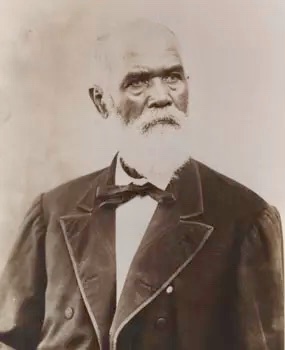
Andrew Johnson, who became the 17th U.S. president following the assassination of Abraham Lincoln, was one of the last U.S. Presidents to personally own slaves. Johnson also oversaw the first years of the Reconstruction era as the head of the executive branch of the U.S. government. This professional obligation clashed with Johnson's long-held personal resentments: "Johnson's attitudes showed much consistency. All of his life he held deep-seated Jacksonian convictions along with prejudices against blacks, sectionalists, and the wealthy." Johnson's engagement with Southern Unionism and Abraham Lincoln is summarized by his statement, "Damn the negroes; I am fighting these traitorous aristocrats, their masters!"

The Andrew Johnson alcoholism debate is the dispute, originally conducted amongst the general public, and now typically a question for historians, about whether or not Andrew Johnson, the 17th president of the United States, drank to excess. There is no question that Andrew Johnson consumed alcohol ; the debate concerns whether or not he was governing drunk, how alcohol may have altered his personality and disrupted his relationships, and if, when, or how it affected his political standing, and even his current bottom-quartile historical assessment. Less so today, but in his own time, Johnson's alleged drinking contributed substantially to how his peers evaluated his "attributes of mind, character, and speech...where the good ruler is temperate, Johnson is an inebriate; where the good ruler is selfless, Johnson is self-regarding; where the good ruler is eloquent, Johnson is a rank demagogue...behind all these assumptions is the still and silent image of the Great Emancipator, but that is another story."
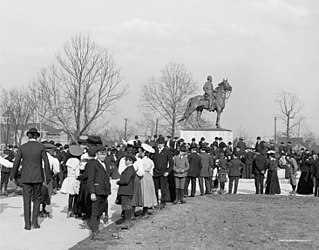
This is a bibliography of works about Nathan Bedford Forrest (1821–1877), an American slave trader, cotton plantation owner, Confederate cavalry leader, railroad executive, and Grand Wizard of the First Klan.

Andy's Trip is a multi-panel political cartoon by American artist Thomas Nast depicting the 1866 electioneering trip of U.S. president Andrew Johnson that came to be known as the Swing Around the Circle. Published as a double-page spread in the October 27, 1866 issue of Harper's Weekly, the image "delivered a blow" and served as a "visual indictment of Johnson's behavior during his swing around the circle, divided by two dozen panels, with Johnson at the center wearing a halo and smiling beneath the words, a takeoff from his New York speech: 'Who has suffered more for you and for this Union than Andrew Johnson?'" According to historian Fiona Halloran, "Hammering away, Nast insisted that it was Johnson who 'forgot' Union veterans and Union families."

















